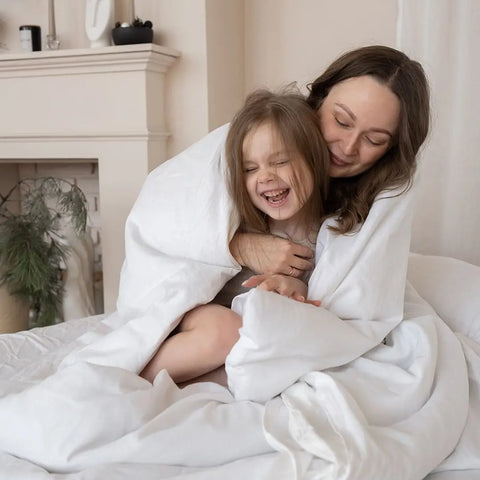How to Choose Hypoallergenic Bed Linen
Mood and productivity during the day largely depends on the quality of our sleep. A person who gets a good night's sleep, is alert and active, copes with the tasks set faster, so the quality sleep is absolutely necessary for our well-being. You may be surprised, but hypoallergenic bed linen has a huge impact on the quality of sleep. It is advisable to think about the quality and safety of bed linen in advance, since the number of allergens to which an increased reaction of the body appears, as a rule, increases over the years.
Textiles have the ability to accumulate dust and attract various allergens that can disrupt sleep and pose a serious danger to health in general. Allergy to dust affects about 40% of the world's population, and if you add mold, fluff and allergic dermatitis, it becomes clear that allergy is the disease of the 21st century. Its manifestations are in many ways similar to the symptoms of acute respiratory infections, which is why many people do not even realize that a sneeze, runny nose or cough appeared because, for example, a dust mite got in his bed.
Fortunately, this unpleasant problem has a fairly simple solution – hypoallergenic bed linen.
What is hypoallergenic bed linen and how can it help your sleep?

The problem is that different types of allergens target different areas of your bed. Mold is more likely to develop in the wetter areas of your bed, while dust mites are more likely to accumulate in the fabric and in the filler for blankets and pillows. Real hypoallergenic bed linen should protect against all allergens, not contain dangerous chemical compounds, harmful dyes or flavors.
We have prepared for you some tips on creating a favorable and safe atmosphere in your bedroom. Observing only 3 of these tips, you can significantly reduce the number of allergens in your bedroom.
Start using bedding made of natural materials

That's why natural fabrics do not lose their value nowadays, because no synthetic material can boast such resistance to various allergens as organic cotton and linen have.
In addition, bedding made of synthetic material often cause tissue dermatitis. In most cases, the cause of an allergic reaction is polyester fiber, or rather, formaldehyde resins and dispersion dyes that are part of it. Sometimes manufacturers deliberately do not refuse to use aggressive chemical compounds, since chemistry reduces the cost of the manufacturing process and makes synthetic fabrics shiny and resistant to crumpling.
Of all the variety of natural fabrics, it has hypoallergenic properties: flax, cotton, exotic fabrics made of eucalyptus, bamboo and nettle.
But! Bed textiles (even from natural fabrics) can be considered safe for allergy sufferers only if pesticides were not used in the cultivation of the plant, and various chemicals were not used in the production of fabric fibers to soften and stabilize the color.
For example, if you bought bright bed linen made of 100% cotton, and it glitters and practically does not crumple, there is a risk that the fabric has been additionally treated with chemicals that can provoke an allergic reaction.
However, this does not mean that we should deny ourselves the pleasure of buying colorful soft products. The guarantee of quality and hypoallergenic is not so much the natural composition of the fabric, as the presence of special quality certificates from the manufacturer.
The unconditional guarantee of the safety of a textile product is the international certification of Oeko-Tex. During the inspection, the fabric is evaluated for compliance with the pH norm, for the presence of heavy metals, formaldehydes and chlorine-containing substances, as well as for the content of allergenic dyes. The manufacturer's Oeko-Tex certificate means that all the materials of the product — from fabric fibers to buttons and dyes used in production — are hypoallergenic and non-toxic.
Tintory sells in accordance with the standards of OEKO-TEX 100. Our textiles are environmentally friendly and suitable for allergy sufferers, people with sensitive skin and for young children. Linen fabric is much healthier due to its natural hypoallergenic and antibacterial properties. In addition, linen bedding has excellent thermoregulation, allows the skin to breathe and prevents the formation of mold.
Use hypoallergenic products

Skin particles, bacteria, dust mites and various allergens accumulate in your bed linen over time. That is why it is so important to properly care for bedding. It is advisable to wash bed linen separately from other things and, of course, do not use chlorine-containing powders and bleach. We advise you to read the label carefully and choose gels and powders without aggressive phosphate additives. Hypoallergenic products have a safe composition, make the water softer, wash off well and do not accumulate in the product.
Choose a high-quality filler for pillows and blankets
The most allergenic fillers are considered to be feather and fluff of birds. When the first symptoms of allergy appear, we recommend replacing pillows and blankets with safe and clean ones, or even better — with new and hypoallergenic ones. If there is a smell of dampness in your bedroom, then there is a suspicion that there is mold in your sleeping accessories, in that case it is also better to throw them away. And dry the new ones regularly in the sun.
To prevent dust from accumulating in the blanket and pillows, they must be washed regularly or given to cleaning. And as an additional protection, you can purchase special dust covers. We would like to add that it is not only those who have already noticed signs of allergies who should think about the hypoallergenic bedding.

